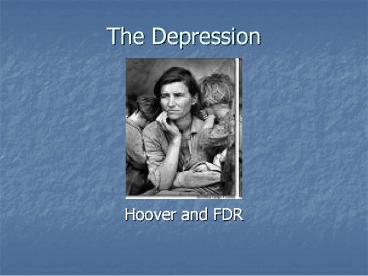The Depression - PowerPoint PPT Presentation
1 / 20
Title:
The Depression
Description:
The Depression Hoover and FDR Herbert Hoover Elected in 1928 primarily because the Republicans were associated with prosperity Believer in individualism, free ... – PowerPoint PPT presentation
Number of Views:85
Avg rating:3.0/5.0
Title: The Depression
1
The Depression
- Hoover and FDR
2
Herbert Hoover
- Elected in 1928 primarily because the Republicans
were associated with prosperity - Believer in individualism, free enterprise, and
laissez-faire
3
Conditions which helped produce or intensify the
Depression
- Overproduction
- Unequal distribution of wealth
- Overexpansion of credit
- The depressed condition of agriculture
- Stock Market speculation buying on margin
- Unwise government policies
- High tariff, no curbs on Stock Market
4
Hoover Policies
- Calls for voluntary cooperation
- Asks leading industrialists not to cut pay,
production, or workers - Asks labor leaders to discourage demands for
strikes and higher pay - Asks governors and mayors to spend more on public
works to create jobs - But economy continues to tumble
5
Hoover
- Optimistic prosperity just around the corner
6
Agricultural Marketing Act
- 1929
- To help farmers help themselves, largely through
producers cooperatives - Established Federal Farm Board which had no real
power to reduce production.
7
Hawley-Smoot Tariff
- 1930
- Increased prices on foreign-made goods
- Intended to increase buying of American-made
goods - European countries responded with tariffs on
American-made goods. - Not successful.
8
FDR and the New Deal
- I pledge you, I pledge myself, to a new deal for
the American people. - Election of 1932 ushered in an era of a different
kind of a politician. - Master politician intelligent, confident,
charming - Master communicator fireside chats
9
Preparing to Lead
- The Cabinet Frances Perkins was the first woman
to hold a Cabinet post (Labor). - The Brain Trust Informal group of advisors
consisting of intellectuals, lawyers, and
economists - Humanitarian wife Eleanor had a great deal of
influence.
10
New Deal in Action
- RELIEF for those people who were suffering.
- RECOVERY for the economy so that it could grow
again. - REFORM measures in order to insure against future
depressions.
11
Stages of the New Deal
- 1933-1935 dealt with relief and recovery most
passed in the First Hundred Days - 1935-1936 The Second New Deal focused more on
social reform - 1936 election high point of the N.D.
- 1937-1938 recession due in part to New Deal
cutbacks in spending - 1938 N.D. ended to opposition in Congress and
WWII
12
New Deal Strategies
- Use of commerce and elastic clauses of the
Constitution to take direct government action. - Fiscal action to stimulate economy and lower
unemployment by lowering taxes and increasing
government spending. - Government responsibility for the general welfare
of citizens. - Increase regulatory role over banks, businesses,
and the stock exchange. - Deficit spending Keynesian Economics
13
Relief Legislation
- Emergency Banking Act (1933)
- Federal Emergency Relief Act (FERA) (1933)
- Public Works Administration (PWA) (1933)
- Civilian Conservation Corps (CCC) (1933)
- Works Progress Administration (WPA) (1935)
14
Recovery Legislation
- National Industrial Recovery Act (NIRA) 1933
- Home Owners Loan Corporation (HOLC) 1933
- Federal Housing Administration (FHA) 1934
- First and Second Agricultural Adjustment Acts
(AAA) (1933 and 1937) - Tennessee Valley Authority (TVA) (1933)
15
Reform Legislation
- Glass-Steagall Banking Act (1933) created the
FDIC - Securities Exchange Act (1934)
- Social Security Act (1935)
- National Labor Relations Act (1935) also known
as the Wagner Act collective bargaining - Fair Labor Standards Act (1938) set a minimum wage
16
Reactions to the New Deal
- FDR built up a New Deal coalition
- Solid Democratic South
- new immigrant workers
- Big cities
- African-Americans
- Organized labor
- Elderly
- Business people
- farmers
17
Criticism to the New Deal
- Strongest opposition came primarily from Big
Business - American Liberty League attacked FDR for using
too much power free enterprise was being
attacked - Dr. Francis Townsend provide government pensions
for the elderly - Father Charles E. Coughlin blamed business
owners, especially Jewish ones, for the economic
crisis - Senator Huey Long income and inheritance taxes
on wealthy to give each American a 2500 income,
a car, and a college education
18
Supreme Court Reacts to New Deal
- NIRA declared unconstitutional in Schecter
Poultry Corporation v. United States (1935) law
illegally gave power to Congress to regulate
intrastate commerce - United States v. Butler (1936) ruled that AAA was
unconstitutional on grounds that agriculture was
a local matter
19
FDR Reacts to New Deal
- Court-Packing FDR asked Congress to increase
the number of judges from 9 to 15 - Aimed at making the S.C. approve the N.D.
20
Andrew Mellon
- Secretary of the Treasury
- Believed course of depression had to be run
- Depression a good thing because values would be
adjusted, people will work harder

